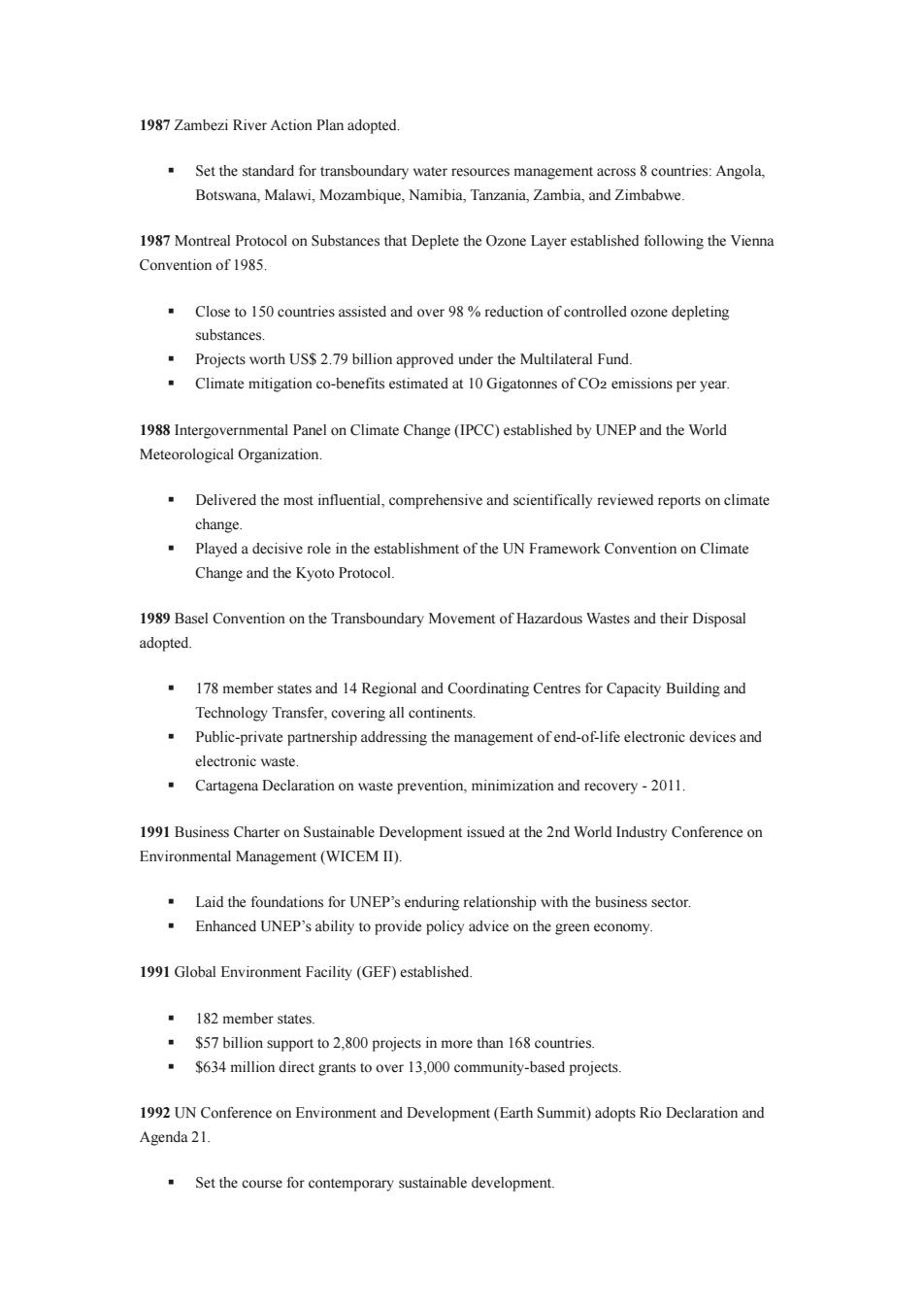正在加载图片...

1987 Zambezi River Action Plan adopted. "Set the standard for transboundary water resources management across 8 countries:Angola, Botswana,Malawi,Mozambique,Namibia,Tanzania,Zambia,and Zimbabwe. 1987 Montreal Protocol on Substances that Deplete the Ozone Layer established following the Vienna Convention of 1985. "Close to 150 countries assisted and over 98%reduction of controlled ozone depleting substances. Projects worth US$2.79 billion approved under the Multilateral Fund. Climate mitigation co-benefits estimated at 10 Gigatonnes of CO2 emissions per year. 1988 Intergovernmental Panel on Climate Change(IPCC)established by UNEP and the World Meteorological Organization "Delivered the most influential,comprehensive and scientifically reviewed reports on climate change "Played a decisive role in the establishment of the UN Framework Convention on Climate Change and the Kyoto Protocol. 1989 Basel Convention on the Transboundary Movement of Hazardous Wastes and their Disposal adopted. 178 member states and 14 Regional and Coordinating Centres for Capacity Building and Technology Transfer,covering all continents. Public-private partnership addressing the management of end-of-life electronic devices and electronic waste. "Cartagena Declaration on waste prevention.minimization and recovery-2011. 1991 Business Charter on Sustainable Development issued at the 2nd World Industry Conference on Environmental Management(WICEM II). "Laid the foundations for UNEP's enduring relationship with the business sector. Enhanced UNEP's ability to provide policy advice on the green economy. 1991 Global Environment Facility (GEF)established. 182 member states. $57 billion support to 2,800 projects in more than 168 countries. $634 million direct grants to over 13.000 community-based projects. 1992 UN Conference on Environment and Development(Earth Summit)adopts Rio Declaration and Agenda 21. "Set the course for contemporary sustainable development.1987 Zambezi River Action Plan adopted. Set the standard for transboundary water resources management across 8 countries: Angola, Botswana, Malawi, Mozambique, Namibia, Tanzania, Zambia, and Zimbabwe. 1987 Montreal Protocol on Substances that Deplete the Ozone Layer established following the Vienna Convention of 1985. Close to 150 countries assisted and over 98 % reduction of controlled ozone depleting substances. Projects worth US$ 2.79 billion approved under the Multilateral Fund. Climate mitigation co-benefits estimated at 10 Gigatonnes of CO₂ emissions per year. 1988 Intergovernmental Panel on Climate Change (IPCC) established by UNEP and the World Meteorological Organization. Delivered the most influential, comprehensive and scientifically reviewed reports on climate change. Played a decisive role in the establishment of the UN Framework Convention on Climate Change and the Kyoto Protocol. 1989 Basel Convention on the Transboundary Movement of Hazardous Wastes and their Disposal adopted. 178 member states and 14 Regional and Coordinating Centres for Capacity Building and Technology Transfer, covering all continents. Public-private partnership addressing the management of end-of-life electronic devices and electronic waste. Cartagena Declaration on waste prevention, minimization and recovery - 2011. 1991 Business Charter on Sustainable Development issued at the 2nd World Industry Conference on Environmental Management (WICEM II). Laid the foundations for UNEP’s enduring relationship with the business sector. Enhanced UNEP’s ability to provide policy advice on the green economy. 1991 Global Environment Facility (GEF) established. 182 member states. $57 billion support to 2,800 projects in more than 168 countries. $634 million direct grants to over 13,000 community-based projects. 1992 UN Conference on Environment and Development (Earth Summit) adopts Rio Declaration and Agenda 21. Set the course for contemporary sustainable development